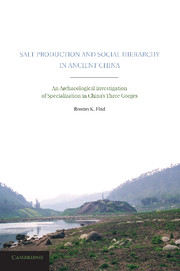 Salt Production and Social Hierarchy in Ancient China
Salt Production and Social Hierarchy in Ancient China Book contents
- Frontmatter
- Contents
- List of Figures and Tables
- Acknowledgments
- Prologue
- 1 Introduction
- 2 Production and Specialization in Complex Societies
- 3 Ancient Salt Production in Sichuan
- 4 The Zhongba Site
- 5 Ceramic Evidence
- 6 Parameters of Production According to Ceramics
- 7 Features and Spatiality
- 8 Animal Remains and Divination
- 9 Conclusions and Implications
- Epilogue
- Appendix A Chinese and Japanese Term List
- Appendix B The (t) Value and Average Thickness for Each Level Excavated in DT0202
- Appendix C Calculating the Scale of Production Using Briquetage from DT0202
- Appendix D Taxon List for Specimens Recovered from DT0202 with Number of Identified Specimens and Minimum Number of Individual Count by Phase and Subphase
- Notes
- Bibliography
- Index
6 - Parameters of Production According to Ceramics
Published online by Cambridge University Press: 07 September 2011
- Frontmatter
- Contents
- List of Figures and Tables
- Acknowledgments
- Prologue
- 1 Introduction
- 2 Production and Specialization in Complex Societies
- 3 Ancient Salt Production in Sichuan
- 4 The Zhongba Site
- 5 Ceramic Evidence
- 6 Parameters of Production According to Ceramics
- 7 Features and Spatiality
- 8 Animal Remains and Divination
- 9 Conclusions and Implications
- Epilogue
- Appendix A Chinese and Japanese Term List
- Appendix B The (t) Value and Average Thickness for Each Level Excavated in DT0202
- Appendix C Calculating the Scale of Production Using Briquetage from DT0202
- Appendix D Taxon List for Specimens Recovered from DT0202 with Number of Identified Specimens and Minimum Number of Individual Count by Phase and Subphase
- Notes
- Bibliography
- Index
Summary
Up to this point, I have discussed the types of data with which we can assess ceramic production and use and the two principal data sets available from the excavations at Zhongba – complete vessels and sherds from the W.S. sample areas. Here I use these data to examine the various parameters that compose the organization of ceramic production and use at Zhongba.
identifying specialization
First we must consider whether the ceramic remains from DT0202 indicate specialized production of ceramics, on the one hand, and the use of ceramics in specialized production (of salt), on the other. To satisfy the broadest definition of specialization,we should minimally demonstrate that the product was being produced for consumption beyond a household. To do so, we should show that any single episode of manufacture created more of the product than could be used by an individual kin group. To further demonstrate that the production and use of the ceramics at Zhongba indicate specialized production involving a division of labor associated with social complexity (a perspective I have termed producer specialization; see Flad and Hruby 2007), we must show that time was invested in the production in lieu of other activity. To demonstrate this requires either that the time investment was substantial and therefore precluded other activities or that some necessary resources were unavailable locally and were acquired by trading the locally overproduced item.
- Type
- Chapter
- Information
- Salt Production and Social Hierarchy in Ancient ChinaAn Archaeological Investigation of Specialization in China's Three Gorges, pp. 110 - 142Publisher: Cambridge University PressPrint publication year: 2011


